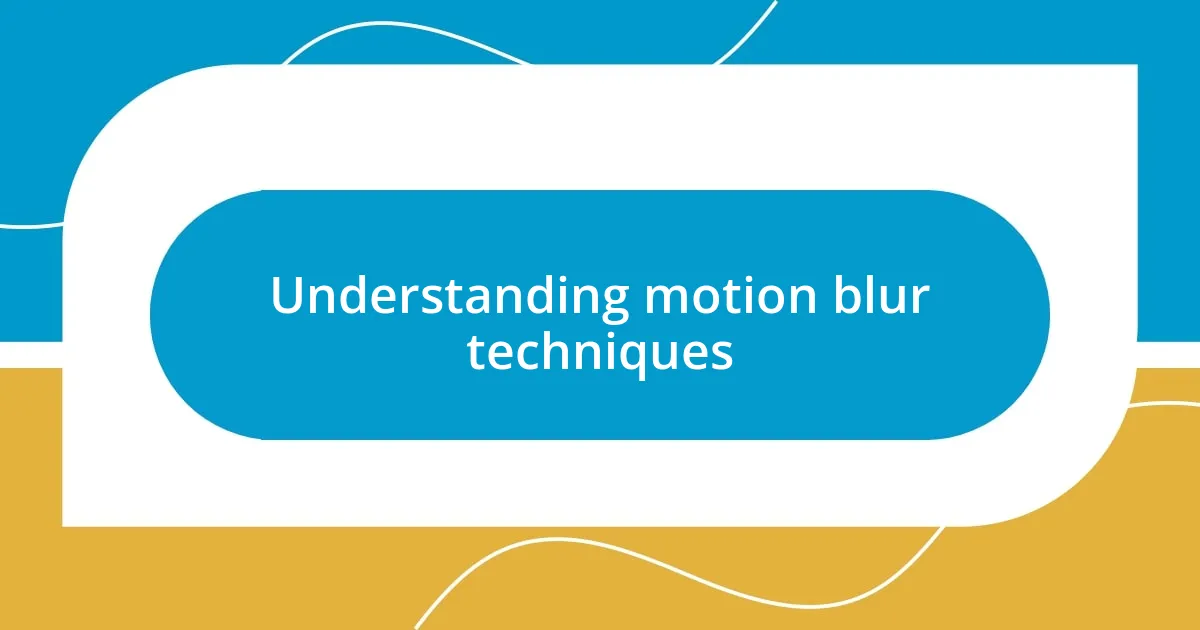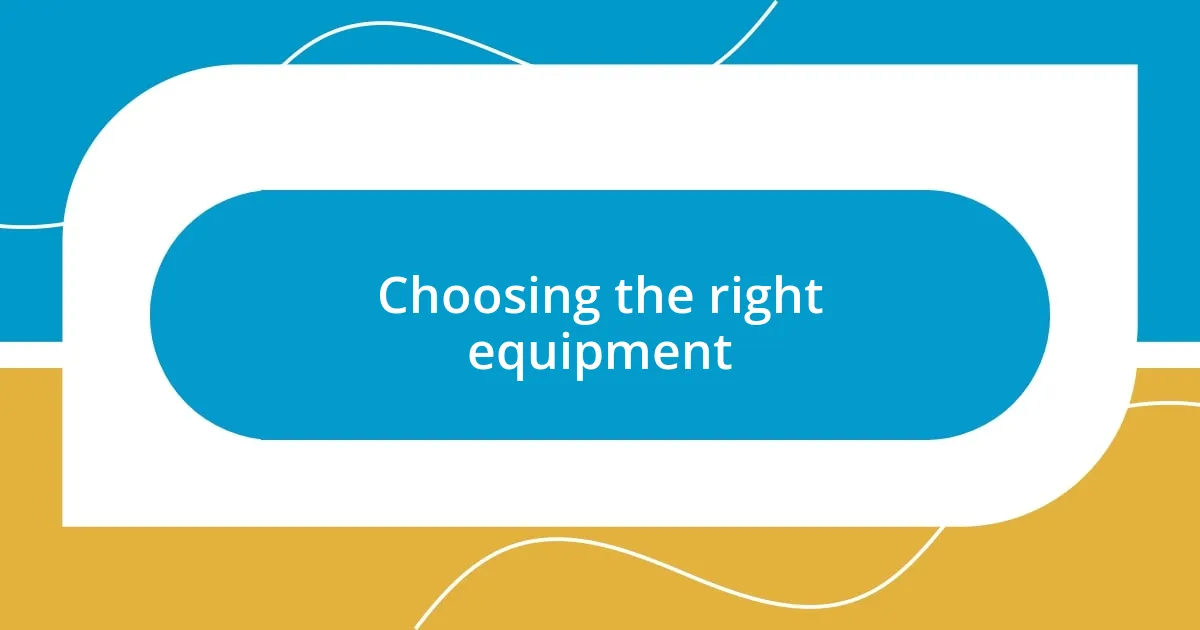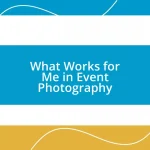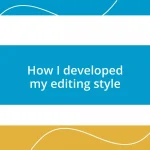Key takeaways:
- Master key techniques for capturing motion blur: adjust shutter speed for desired effect, use panning to convey speed, and employ creative angles for unique perspectives.
- Choose appropriate equipment, such as DSLR or mirrorless cameras for manual control, wide aperture lenses for bokeh, and sturdy tripods for stability during longer exposures.
- Post-processing plays a crucial role in enhancing motion blur images, including adjustments to contrast, color balance, and sharpness to bring out the emotion of the shot.
- Showcase your motion blur art through storytelling in presentations and engaging audiences on social media with behind-the-scenes content to foster community interaction.

Understanding motion blur techniques
In my experience, capturing motion blur effectively hinges on mastering a few key techniques. One method I often use is adjusting the shutter speed; a slower speed can create that dreamy, fluid feel, while a faster one can still hint at movement without losing clarity. Have you ever noticed how a runner’s legs can look like a blur, yet their facial expression remains sharp? That contrast emphasizes both the motion and the emotion.
Another technique I find invaluable is panning, which involves moving the camera along with the subject. I vividly remember a day at the park, trying to capture my daughter on her bike. As I panned with her, I felt this rush of excitement, knowing I was freezing a fleeting moment in time while conveying her speed. It was exhilarating to see the background streak by, and I realized this approach adds not just motion, but also context to the image.
Finally, don’t underestimate the power of creativity. I’ve played around with different angles and perspectives, sometimes including objects in motion closer to the camera to enhance the effect. Each shot turned out uniquely, inviting viewers to feel the energy of the moment. Have you tried experimenting in this way? Exploring motion blur can reveal a world of possibilities that you might not have considered before.

Choosing the right equipment
Choosing the right equipment is vital for capturing the essence of motion blur. For this type of photography, I often reach for a DSLR or mirrorless camera, as they typically allow for greater manual control over your settings. One time, while covering a local race, my older point-and-shoot simply couldn’t keep up with the speed of the runners, so investing in a quality camera now feels like a game-changer for my work.
Lenses also play a crucial role in achieving the desired effect. Wide aperture lenses, like a 50mm f/1.8, can create beautiful bokeh that complements the motion within the frame. I remember using my 70-200mm lens during a high-speed bike event. It not only gave me the distance I needed but also captured the blur perfectly, resulting in an emotional shot of determination against a rushing backdrop.
Lastly, don’t overlook how essential a sturdy tripod is for longer exposures. When I attempted night photography of a bustling city street, the tripod was my best friend. It steadied my camera long enough for the lights and movement to create mesmerizing trails without any pesky camera shake. Choosing the right equipment truly enhances your ability to explore and capture motion blur artfully.
| Equipment | Benefits |
|---|---|
| DSLR/Mirrorless Camera | Greater manual control for shutter speed adjustments |
| Wide Aperture Lens (e.g., 50mm f/1.8) | Beautiful bokeh and depth of field enhancements |
| Sturdy Tripod | Stable shots during longer exposure times |

Setting up for motion blur
Setting up for motion blur requires a few deliberate choices that can dramatically impact your final image. When I prepare for a shoot, I often find a quiet moment to assess my surroundings. This contemplation allows me to identify the movement I want to capture—be it my kids playing in the park or bustling city life. The excitement is palpable, as I imagine the images coming to life with motion.
As I set up, I pay close attention to the following aspects:
- Shutter Speed: Opt for a slower speed to create fluid motion, adjusting as needed based on the subject’s pace.
- Focus: Ensure you lock focus on the subject while allowing the background to blur beautifully.
- Stabilization: Use a tripod or image stabilization features, especially for longer exposures, to avoid unwanted shake.
- Lighting: Consider your light sources; low light can enhance the effect, but you may need to compensate with higher ISO settings.
- Composition: Plan your framing carefully. Having foreground elements can add depth and context to the motion.
The process of preparing truly enhances the anticipation I feel. I recall a rainy afternoon when I took my camera to capture passing cars on a slick road. As I adjusted my settings, I could almost hear the raindrops sizzling against the asphalt, and I was eager to see how those droplets would create a painting-like effect with the motion. It’s those little details that make setting up for motion blur not just a task, but a part of the creative journey.

Experimenting with shutter speed
Experimenting with shutter speed can drastically alter the mood of your photos. I remember one evening when I was photographing my dog running through a field. By slowing down the shutter speed to about 1/30 of a second, I captured not just his movement but also the way his fur blended seamlessly into the wildflowers around him. It’s captivating how a simple change can transform an ordinary snapshot into something that feels alive, don’t you think?
Finding that sweet spot in shutter speed often involves a bit of trial and error. I once spent an afternoon at a local skate park, fiddling with the settings as skaters whizzed by. At first, using a shoot-fast shutter speed, I captured crisp action but found it lacked emotion. When I shifted to a slower speed, the trails of their boards and bodies began to weave into the composition, telling a story of motion and energy. Have you ever had that thrilling moment of discovery when the numbers on your camera reveal an unexpected treasure?
It’s also important to consider the lighting as you adjust your shutter speed. During a sunset shoot at the beach, I had to experiment quite a bit. With the golden light fading, I had to lower my shutter speed to catch the silky waves washing ashore without overexposing the sky. The result was a mesmerizing contrast of the soft, flowing water against the sharp silhouettes of surfers in motion. It’s in these moments of adjustment that you truly feel the pulse of your surroundings and how they interact with your craft. How often have you captured a scene where the interplay between speed and light revealed something more than what your eyes could see?

Composing your shot creatively
It’s fascinating how composing your shot creatively can turn a simple scene into something spectacular. I recall a sunny afternoon at a bustling street fair. I found a unique angle, framing the colorful booths and people moving through them. By incorporating some blurred figures in the foreground, I added a sense of life and vibrancy to my image, creating a visual narrative that drew viewers into the energy of the moment. Do you see how such choices can elevate an ordinary snapshot into an engaging story?
Another aspect I love to consider is the rule of thirds. This technique can help you position your subject in a compelling way. I remember capturing a cyclist zooming down the street during an evening race. I placed him off-center and focused on the leading lines of the road, which not only added depth but also guided the viewer’s eye right to the motion. It made the image feel dynamic and alive, don’t you think?
I often play with negative space, too. One chilly morning, I set out to photograph a lone bird taking flight against a vast, empty sky. By leaving ample space around it, I emphasized its movement and freedom, contrasting beautifully with the stillness of the background. This minimalist approach brought a sense of serenity and profound simplicity to the shot. Have you ever tried using negative space to enhance the feeling of motion in your own compositions? Sometimes, less really is more!

Post-processing motion blur images
Post-processing motion blur images can transform good shots into extraordinary works of art. After capturing a mesmerizing shot of a running cyclist, I dove into post-processing to amplify that sense of speed. By adjusting contrast and adding a slight vignette, I accentuated the motion blur, which not only drew the viewer’s gaze to the action but also set a mood that felt kinetic and vibrant. Have you ever noticed how small tweaks can completely alter the emotion of your image?
I also love playing with color balance in post-processing. For instance, I once captured a dreamy image of rushing pedestrians against a sunset. By shifting colors to enhance the warm tones, the image evoked a feeling of nostalgia, as if time itself had slowed down just to allow those fleeting moments to sink in. It made me wonder, how often do we overlook the emotional potential of color in our photography?
Enhancing sharpness is another effective technique, especially when working with motion blur. I remember editing a photo where a dancer leaped mid-air, her limbs gracefully blurred while the background retained its crisp details. By sharpening the edges around her to create a contrast with the softness, the image became not only striking but also a true testament to the beauty of movement. This process made me reflect on how we can guide the viewer’s attention through selective focus. Isn’t it fascinating how a little post-processing can bring your creative vision to life?

Showcasing your motion blur art
When it comes to showcasing motion blur art, the presentation plays a crucial role. I remember displaying a series of my motion blur photographs at a local gallery. Each piece was accompanied by a short story about the moment captured, inviting viewers to step into my shoes. This connection made the experience interactive; I found that people not only appreciated the visuals but also resonated with the emotions behind the shots. Isn’t it incredible how sharing the journey can enrich the viewer’s experience?
Another method I’ve enjoyed is using social media to highlight my motion blur art. I often post behind-the-scenes clips that reveal my thought process, like scouting locations or experimenting with different shutter speeds. Once, I shared a video of myself photographing cyclists zooming by, and the engagement was fantastic! Questions poured in about my techniques and inspirations, creating a dialogue that continued long after the post. Don’t you think these interactions can foster a community around your art?
I’ve found that creating themed collections can emphasize certain aspects of motion blur effectively. For instance, I once curated a series focused on urban life, capturing the blur of passing cars and hurried pedestrians. Displaying these pieces side by side not only showcased the diversity of movement but also created a visual rhythm that echoed the city’s heartbeat. It’s an exciting way to tell a broader story through a carefully crafted series — how do you see your art fitting into a larger narrative?














